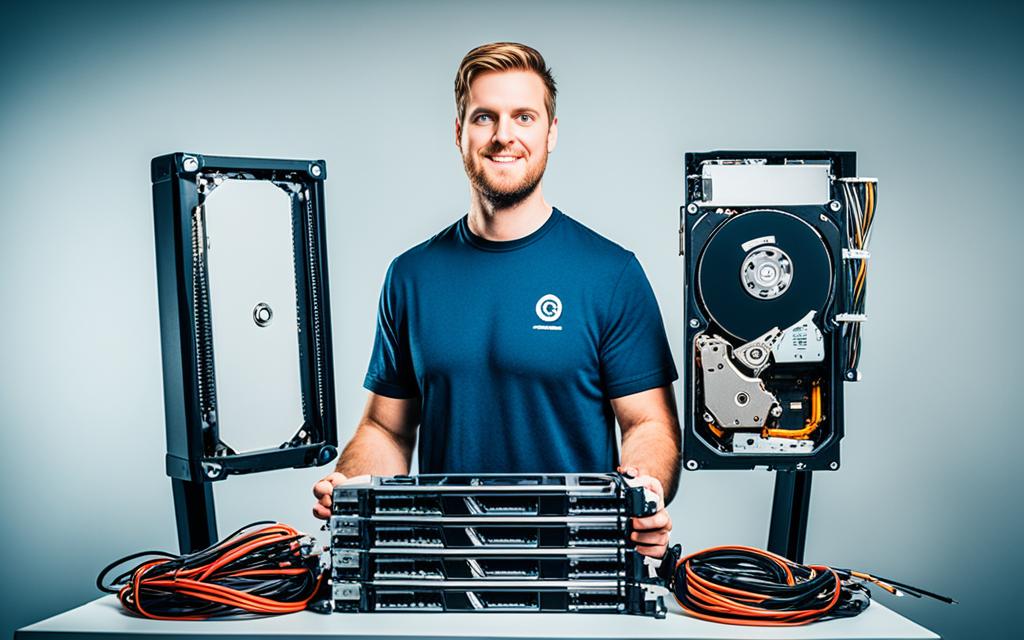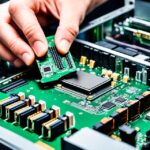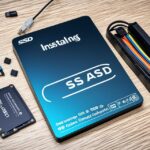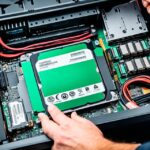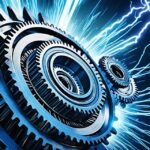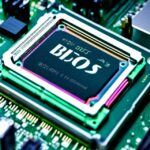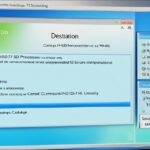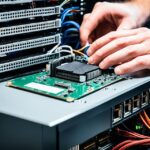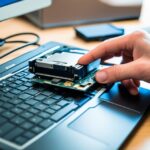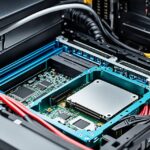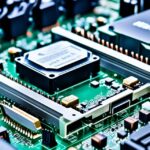Table of Contents
Adding a new hard disk drive (HDD) to your computer is a key step. It’s important for a smooth computer use. Knowing how to make your computer recognize the new HDD is crucial. The Windows Disk Management tool is very important for this. It helps with setting up new hard drives. Remember, most new hard drives come empty. They need you to format and prepare them for use1.
There are several steps to upgrade your storage. Once your system sees the new drive, its potential grows. Understanding how to make your computer see the drive can make things less worrying. It turns a daunting task into an enjoyable one.
Key Takeaways
- Using Windows Disk Management is essential for detecting and initializing new HDDs.
- Blank drives require proper formatting before they can be accessed.
- Improper connections can hinder the recognition of your hard drive.
- Selecting the right partition style (MBR vs. GPT) is critical for optimising new storage devices.
- Regular updates to disk drivers can prevent detection issues in Windows 10.
The Importance of Detecting a New HDD
Spotting a new hard drive is key to better storage solutions for everyone. With our digital world growing fast, knowing your storage needs is more important than ever. More data means we need more places to keep it all. Figuring out the perfect HDD size makes work flow smoothly and boosts productivity.
Understanding Storage Needs
As digital content grows, keeping up with storage can be tough. Knowing when it’s time for an upgrade helps keep your system running well. Outdated storage can slow you down and mess up your work. Knowing what you need helps you pick the right HDD, so you don’t fall behind.
Benefits of Upgrading Your Storage
Getting a new HDD has lots of perks, like more room for your files. More space means your computer can work better, especially for big tasks like gaming or video editing. A modern hard drive also keeps your data safer and cuts down on errors. Plus, it’s less likely to break, making your system more reliable. Checking if a hard drive is helps you avoid buying a used one by mistake, ensuring top performance and trustworthiness2.
Also, setting up your new HDD correctly is crucial. This supports the need to speed up setup processes, showing why detecting a new HDD is so important3.
Common Reasons Why a New HDD Isn’t Detected
When you plug in a new HDD, it might not show up right away. There are a few common issues that can cause this. It’s good to know the reasons new HDD not detected to fix these issues quickly.
Improper Connections and Power Supply Issues
Connection problems are a frequent cause. If the SATA or power cable isn’t plugged in tight, the drive won’t be recognised. SATA cables should be no more than 39.37 inches long. For ATA drives, don’t use UDMA cabling longer than 18 inches. Long cables can mess up both performance and connection4. Make sure every cable is plugged in well and check for any damage to fix this issue.
Unformatted Drives: What You Need to Know
A new HDD might also go undetected if it hasn’t been formatted yet. Many come this way, looking ‘unknown’ or ‘not initialized’ to your computer. If it’s not set up right, the operating system can’t use the drive. You need to initialise the disk and set up a partition with Windows Disk Management5. This step is key to make the HDD work. Sometimes, setting it up helps recover lost data or make a new space for files.
How to Detect a New HDD: A Step-by-Step Guide
Getting a new hard drive is exciting, but setting it up in Windows needs certain steps. This guide will show you how to do it with Windows’ own tools. This way, you can start using your new HDD smoothly.
Accessing Windows Disk Management
To start, you need to open Windows Disk Management to detect HDD. It’s key for finding new drives. Just right-click on the Windows Start button and pick “Disk Management”. There, all connected drives and their status are listed. If your new drive isn’t in File Explorer, it likely needs to be set up to show up. Most times, a new disk needs to be set up initially to work properly6.
Initialising Your New Drive
In Disk Management, if your new HDD shows as unallocated, you must initialise it. Simply right-click next to the drive’s name and hit “Initialize Disk”. You’ll choose between two partition styles. For big volumes, GUID Partition Table (GPT) is best. Master Boot Record (MBR) fits smaller drives. The system will pick the right one for your drive67.
Formatting the Hard Drive
The last thing to do is format your HDD. When it’s initialised, right-click on the empty space and select “New Simple Volume”. The wizard will help set it up with things like drive letter and system type. NTFS is often chosen for its good fit with Windows. Remember, starting over with your drive erases old files. So, back up what you need first8. Once formatted, your drive is all set to use67.
| Step | Action | Details |
|---|---|---|
| 1 | Access Disk Management | Right-click Start button, select Disk Management |
| 2 | Initialise the Drive | Right-click disk name, choose “Initialize Disk” |
| 3 | Select Partition Style | Choose between GPT or MBR based on needs |
| 4 | Create New Volume | Right-click unallocated space, follow wizard to format |
Advanced Troubleshooting Techniques
If your new HDD isn’t being recognised, you might need to try more complex steps. Checking BIOS settings and device drivers could help find what’s blocking the HDD from being detected. Keeping an eye on these can make your hardware more likely to be recognised correctly.
Checking BIOS Settings
It’s vital to make sure your BIOS settings are correct for HDD detection. When you start your computer, the BIOS needs to recognise the hard drive. Not seeing it there could mean you have to check connections or the HDD itself might need help9.
Updating Device Drivers
Updated device drivers are key to fixing detection problems. If your HDD shows errors like “Not Initialised,” updating drivers could be the solution. By keeping drivers fresh, your system runs better, possibly fixing those annoying issues10.
FAQ
What steps do I need to follow to ensure my new HDD is detected by Windows?
First, physically set up the drive and check that all connections are tight. Then, open Windows Disk Management to set up and format the drive. Remember to choose the right partition style, MBR or GPT, and format it to NTFS or another system.
Why is it important to detect a new HDD?
Detecting a new HDD is vital for increasing your storage space. This is essential for both personal and work-related use. It improves system performance for activities like gaming, video editing, and data management.
What are the common reasons why my new HDD isn’t detected?
Several reasons might cause a new HDD to not be detected. These include loose connections, power supply problems, or if the drive hasn’t been formatted. Connecting issues often come from not securing cables or not having enough power. Remember, most new HDDs need to be set up through Windows Disk Management.
How do I access Windows Disk Management to detect my new HDD?
To open Windows Disk Management, right-click the Start button and select ‘Disk Management’. This shows all your drives. Your new HDD might show as unallocated or ‘unknown’. This is your cue to start the setup.
What do I need to consider when initialising my new drive?
In the initialising process, decide between using Master Boot Record (MBN) or GPT for your drive. MBR suits drives under 2TB. GPT is for larger ones and offers better features like backup and more straightforward partitioning.
How do I format my new hard drive for use?
To format your new hard drive, right-click it in Windows Disk Management. Then, pick ‘Format’, choose NTFS or another file system, and finish the setup. This makes the drive ready for storing your files.
What advanced troubleshooting techniques should I use if the HDD is still undetected?
If your HDD isn’t detected, first check your BIOS settings at startup. Ensure the drive shows up there. If it does, update your device drivers in the Device Manager. Out-of-date drivers can prevent detection.
How can I ensure my device drivers are current?
To keep your device drivers updated, go to Device Manager by right-clicking the Start button. Click ‘Device Manager’, find your HDD under disk drives, and choose ‘Update driver’. Choose to search automatically for driver updates.
Source Links
- https://www.howtogeek.com/268901/why-your-new-hard-drive-isnt-showing-up-in-windows-and-how-to-fix-it/ – Why Your New Hard Drive Isn’t Showing Up in Windows (and How to Fix It)
- https://forums.tomshardware.com/threads/is-my-hard-drive-dead-unknown-device-not-initialized.3794663/ – Question – Is My Hard Drive Dead??? Unknown Device, Not Initialized…
- https://www.ontrack.com/en-us/blog/what-to-do-in-case-of-unrecognized-hard-drive – (External) Hard Drive Not Detected or Not Recognized?
- https://www.seagate.com/support/kb/the-bios-does-not-detect-or-recognize-the-ata-sata-hard-drive-168595en/ – The BIOS does not detect or recognize the ATA / SATA hard drive | Support Seagate US
- https://www.easeus.com/resource/hard-drive-not-showing-up-or-recognized.html – Hard Drive Not Showing Up or Detected in Windows? Learn How to Fix
- https://learn.microsoft.com/en-us/windows-server/storage/disk-management/initialize-new-disks – Initialize new disks
- https://softwarekeep.com/blogs/troubleshooting/solved-hard-drive-not-showing-up-in-windows-10 – Hard Drive Not Showing up in Windows 10
- https://www.diskgenius.com/how-to/hard-drive-not-showing-up.php – Hard drive not showing up or detected? Here are 7 solutions
- https://learn.microsoft.com/en-us/troubleshoot/windows-server/backup-and-storage/troubleshoot-disk-management – Troubleshoot Disk Management – Windows Server
- https://recoverit.wondershare.com/computer-problem/common-hard-drive-problems-and-solution.html – 14 Common Hard Drive Problems and Solutions | Ultimate

